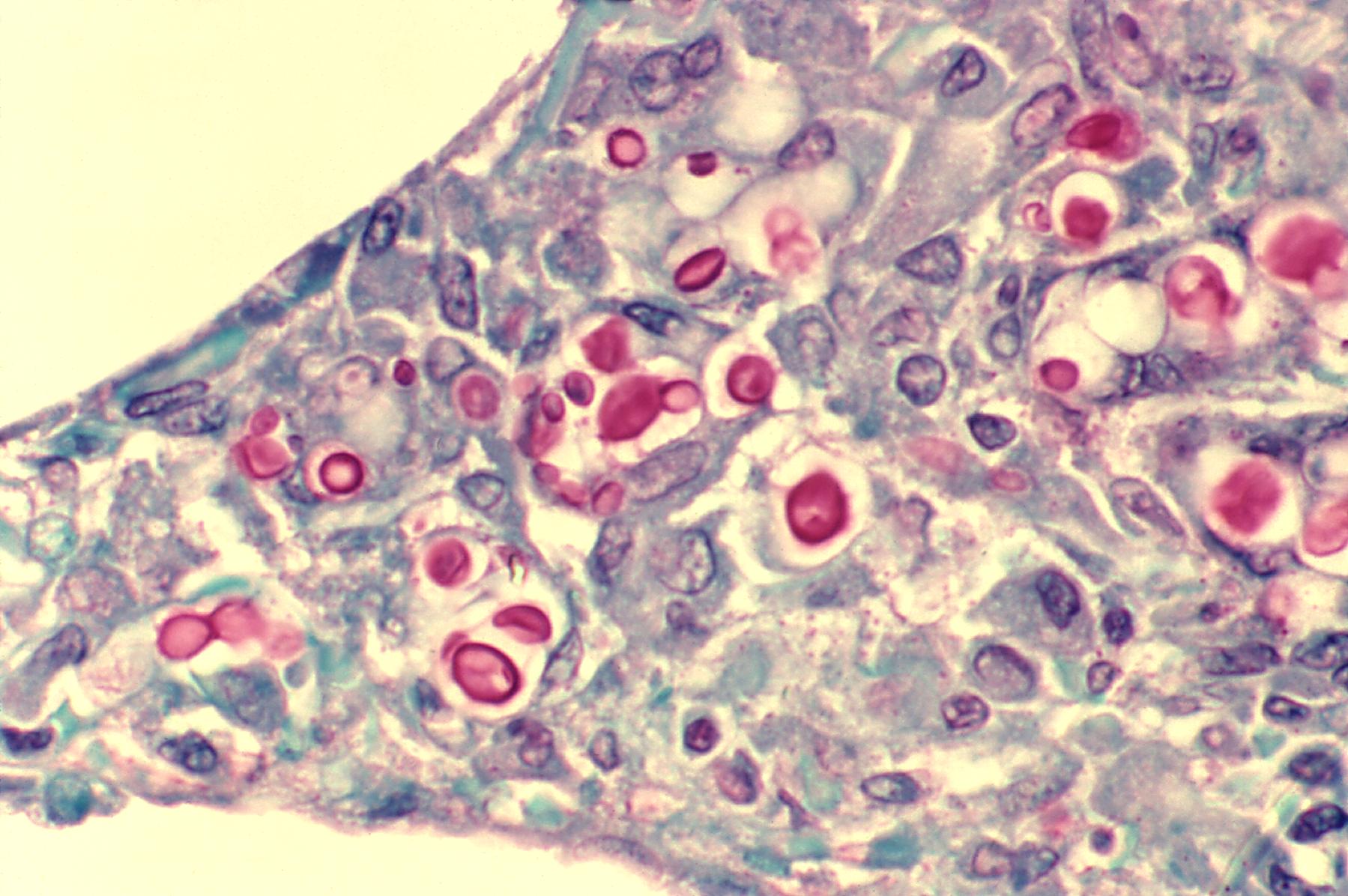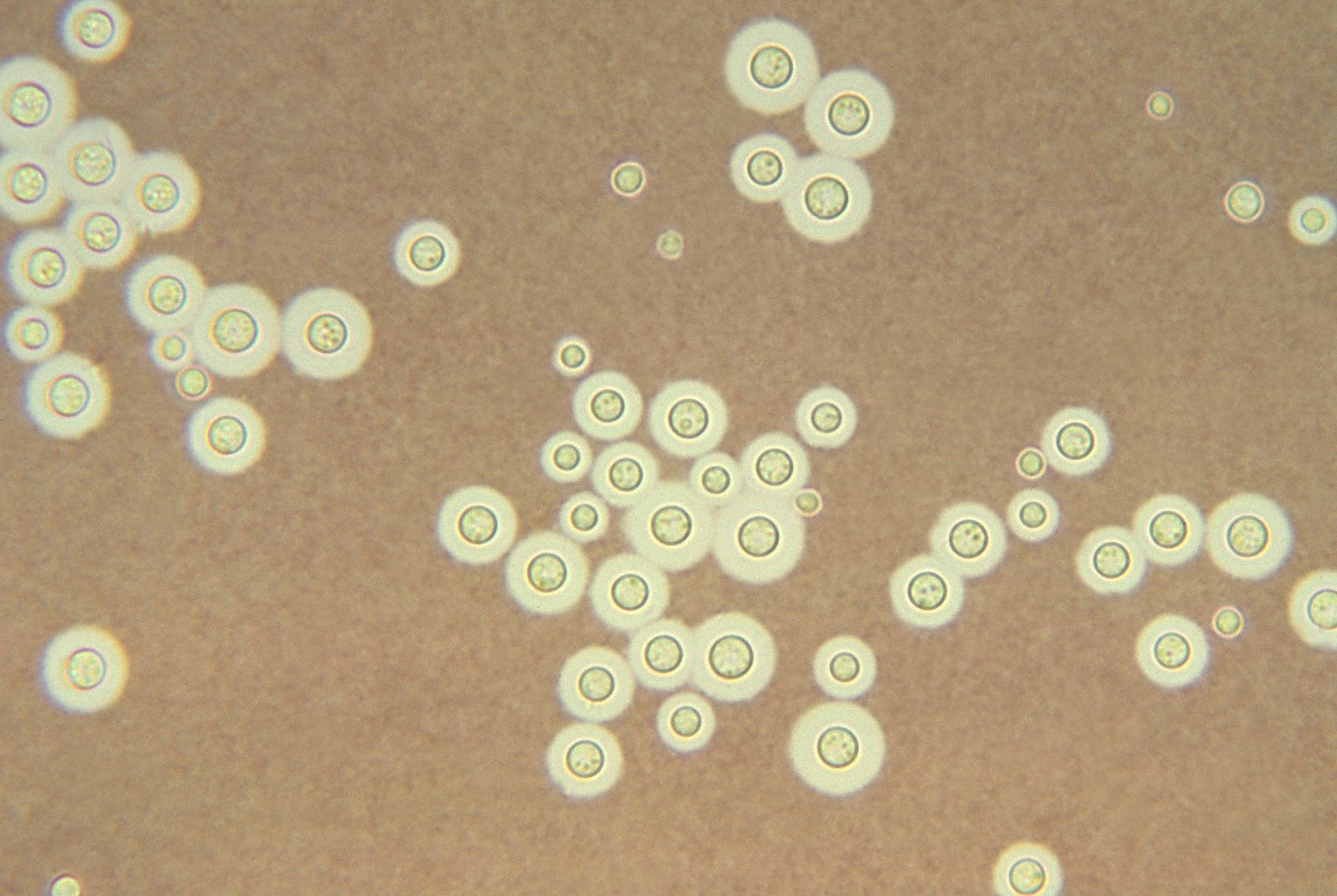Cryptococcosis pathophysiology: Difference between revisions
(Created page with "__NOTOC__ {{Cryptococcosis}} Please help WikiDoc by adding content here. It's easy! Click here to learn about editing. ==Overview== ==Pathoph...") |
m (Bot: Removing from Primary care) |
||
| (25 intermediate revisions by 8 users not shown) | |||
| Line 2: | Line 2: | ||
{{Cryptococcosis}} | {{Cryptococcosis}} | ||
{{CMG}}; {{AE}} {{SSK}}; {{YD}} | |||
==Overview== | ==Overview== | ||
[[Infection|Infective]] [[Cryptococcal infection|cryptococcal]] [[species]] are ubiquitous and natural exposure by [[inhalation]] is very common. [[Cryptococci]] are [[intracellular]] [[pathogens]]. Once they are [[Phagocytosis|phagocytosed]], they [[Germination|germinate]] and multiply within the [[macrophages]]. The [[immune response]] to [[cryptococcal infection]] is highly dependent on host [[T-cell]] function, [[interferon-γ]] and [[Tumor necrosis factor-alpha|TNF-α]] [[Cell signaling|signaling]]. Microscopically, ''[[Cryptococcus neoformans|Cryptococci]]'' are characterized by a thick [[mucopolysaccharide]] [[capsule]] with a refractile center. | |||
==Pathophysiology== | ==Pathophysiology== | ||
===Microscopic Pathology=== | === Transmission === | ||
*[[Infection|Infective]] [[Cryptococcal infection|cryptococcal]] [[species]] are ubiquitous and natural exposure is very common.<ref name="pmid15788512">{{cite journal |vauthors=Wang CY, Wu HD, Hsueh PR |title=Nosocomial transmission of cryptococcosis |journal=N. Engl. J. Med. |volume=352 |issue=12 |pages=1271–2 |year=2005 |pmid=15788512 |doi=10.1056/NEJM200503243521225 |url=}}</ref> | |||
*[[Infection]] occurs by [[inhalation]] of [[Aerosol|aerosolized]], dessicated [[basidiospores]].<ref name="pmid18365996">{{cite journal |vauthors=Jarvis JN, Harrison TS |title=Pulmonary cryptococcosis |journal=Semin Respir Crit Care Med |volume=29 |issue=2 |pages=141–50 |year=2008 |pmid=18365996 |doi=10.1055/s-2008-1063853 |url=}}</ref> | |||
=== Virulence factors === | |||
* Cryptococcus [[polysaccharide]] capsule, [[phospholipase]] activity and [[extracellular]] vesicles play key roles in the survival of the organism within the host.<ref name="pmid25256589">{{cite journal |vauthors=Alspaugh JA |title=Virulence mechanisms and Cryptococcus neoformans pathogenesis |journal=Fungal Genet. Biol. |volume=78 |issue= |pages=55–8 |year=2015 |pmid=25256589 |pmc=4370805 |doi=10.1016/j.fgb.2014.09.004 |url=}}</ref> | |||
=== Pathogenesis === | |||
*Once these spores reach the [[alveoli]], they are [[phagocytosed]] by the [[Macrophages|alveolar macrophages]] without prior [[opsonization]] (usually required for [[yeast]] forms). | |||
*''[[Cryptococcus|Cryptococci]]'' are [[intracellular]] [[pathogens]]. Once they are [[Phagocytosis|phagocytosed]], they [[Germination|germinate]] and multiply within the [[macrophages]].<ref name="pmid7927751">{{cite journal |vauthors=Goldman D, Lee SC, Casadevall A |title=Pathogenesis of pulmonary Cryptococcus neoformans infection in the rat |journal=Infect. Immun. |volume=62 |issue=11 |pages=4755–61 |year=1994 |pmid=7927751 |pmc=303183 |doi= |url=}}</ref> | |||
*Activated [[Macrophage|macrophages]] are capable of destroying the [[yeast]] forms that develop; however, non-activated macrophages act as [[Germination|germination centers]] for [[cryptococci]].<ref name="pmid24660045">{{cite journal |vauthors=Mansour MK, Reedy JL, Tam JM, Vyas JM |title=Macrophage Cryptococcus interactions: an update |journal=Curr Fungal Infect Rep |volume=8 |issue=1 |pages=109–115 |year=2014 |pmid=24660045 |pmc=3958962 |doi=10.1007/s12281-013-0165-7 |url=}}</ref> | |||
*''[[Cryptococcus|Cryptococci]]'' have the ability to form giant cells that resist [[phagocytosis]] and have been hypothesized to play a role in latent [[Infection|infections]], and reactivation.<ref name="pmid24660045" /> | |||
*''[[Cryptococcus|Cryptococci]]'' also have the ability to change the number of sets of [[chromosomes]] they have during [[infection]]; this has been associated with heteroresistance to certain [[antifungal]] agents.<ref name="pmid23836187">{{cite journal |vauthors=Sionov E, Chang YC, Kwon-Chung KJ |title=Azole heteroresistance in Cryptococcus neoformans: emergence of resistant clones with chromosomal disomy in the mouse brain during fluconazole treatment |journal=Antimicrob. Agents Chemother. |volume=57 |issue=10 |pages=5127–30 |year=2013 |pmid=23836187 |pmc=3811407 |doi=10.1128/AAC.00694-13 |url=}}</ref> | |||
=== Host response === | |||
*After exposure to desiccated [[yeast]] cells or [[Spore|spores]], patients may clear the [[infection]], contain it within [[Granuloma|granulomata]] as a latent [[infection]], or the infection may [[Disseminated disease|disseminate]]. This depends on the host's [[immune]] status or other, less well-understood mechanisms. | |||
=== Dissemination === | |||
*[[Disseminated disease]] occurs among patients with compromised [[cell-mediated immunity]]. | |||
*The [[immune response]] to [[cryptococcal infection]] is highly dependent on host [[T-cell]] function, [[interferon-γ]] and [[Tumor necrosis factor-alpha|TNF-α]] [[Cell signaling|signaling]]. | |||
*[[Granuloma]] formation can be seen and may also be responsible for reactivation in patients presenting with [[Immunocompromised host|immunocompromised states]].<ref name="pmid22167400">{{cite journal| author=Brizendine KD, Baddley JW, Pappas PG| title=Pulmonary cryptococcosis. | journal=Semin Respir Crit Care Med | year= 2011 | volume= 32 | issue= 6 | pages= 727-34 | pmid=22167400 | doi=10.1055/s-0031-1295720 | pmc= | url=http://www.ncbi.nlm.nih.gov/entrez/eutils/elink.fcgi?dbfrom=pubmed&tool=sumsearch.org/cite&retmode=ref&cmd=prlinks&id=22167400 }} </ref><ref name="pmid26685750">{{cite journal| author=May RC, Stone NR, Wiesner DL, Bicanic T, Nielsen K| title=Cryptococcus: from environmental saprophyte to global pathogen. | journal=Nat Rev Microbiol | year= 2015 | volume= | issue= | pages= | pmid=26685750 | doi=10.1038/nrmicro.2015.6 | pmc= | url=http://www.ncbi.nlm.nih.gov/entrez/eutils/elink.fcgi?dbfrom=pubmed&tool=sumsearch.org/cite&retmode=ref&cmd=prlinks&id=26685750 }} </ref> | |||
==Microscopic Pathology== | |||
[[File:Cryptococcosis of lung in patient with AIDS Mucicarmine stain.jpg|left|thumb|200px|Cryptococcosis of the lung in patient with [[AIDS]] (Mucicarmine stain), source: wikipedia.org]] | |||
[[File:Cryptococcus_neoformans2.jpg|none|thumb|200px|Cryptococcosis in the [[cerebrospinal fluid]] with light India ink staining, source: wikipedia.org]] | |||
<br> | |||
*[[Cryptococcus]] exists in [[yeast]] form. | |||
*It is round/ovoid and approximately 5-15 μm (resembles ''[[Histoplasma capsulatum|Histoplasma]]'' or ''[[Candida]]'', but often larger). | |||
*It is characterized by a thick [[mucopolysaccharide]] [[Capsule (anatomy)|capsule]] with a refractile center. | |||
*India ink staining is used for easy visualization of the capsule in [[cerebrospinal fluid]].<ref name="pmid8862601">{{cite journal| author=Zerpa R, Huicho L, Guillén A| title=Modified India ink preparation for Cryptococcus neoformans in cerebrospinal fluid specimens. | journal=J Clin Microbiol | year= 1996 | volume= 34 | issue= 9 | pages= 2290-1 | pmid=8862601 | doi= | pmc=PMC229234 | url=http://www.ncbi.nlm.nih.gov/entrez/eutils/elink.fcgi?dbfrom=pubmed&tool=sumsearch.org/cite&retmode=ref&cmd=prlinks&id=8862601 }} </ref> | |||
*It has a tear drop-shaped [[budding]] pattern which is useful for differentiating ''[[Cryptococcus]]'' from ''[[Blastomyces]]'' and ''[[Histoplasma capsulatum|Histoplasma]]''. | |||
*[[Cryptococcus|Cryptococcal infections]] are usually accompanied by very little [[inflammation]]. | |||
*[[Cryptococcus]] stain positive with [[methenamine]] [[Silver stain|silver]], [[Alcian blue]], and [[Periodic acid-Schiff stain|PAS]] (may be confused with corpora amylacea in the [[CNS]]).<ref name="librepath">Fungi. Libre Pathology (2015). http://librepathology.org/wiki/index.php/Fungi#Cryptococcosis. Accessed on December 31, 2015.</ref> | |||
====Cryptococcosis (PAS stain)==== | |||
{{#ev:youtube|ZG0AcmtBLe4}} | {{#ev:youtube|ZG0AcmtBLe4}} | ||
| Line 16: | Line 50: | ||
{{Reflist|2}} | {{Reflist|2}} | ||
[[Category: | [[Category:Fungal diseases]] | ||
[[Category:Disease]] | |||
[[Category:Emergency medicine]] | |||
[[Category:Up-To-Date]] | |||
[[Category:Infectious disease]] | |||
[[Category:Pulmonology]] | |||
[[Category:Neurology]] | |||
[[Category:Dermatology]] | |||
Latest revision as of 21:10, 29 July 2020
|
Cryptococcosis Microchapters |
|
Diagnosis |
|---|
|
Treatment |
|
Case Studies |
|
Cryptococcosis pathophysiology On the Web |
|
American Roentgen Ray Society Images of Cryptococcosis pathophysiology |
|
Risk calculators and risk factors for Cryptococcosis pathophysiology |
Editor-In-Chief: C. Michael Gibson, M.S., M.D. [1]; Associate Editor(s)-in-Chief: Serge Korjian M.D.; Yazan Daaboul, M.D.
Overview
Infective cryptococcal species are ubiquitous and natural exposure by inhalation is very common. Cryptococci are intracellular pathogens. Once they are phagocytosed, they germinate and multiply within the macrophages. The immune response to cryptococcal infection is highly dependent on host T-cell function, interferon-γ and TNF-α signaling. Microscopically, Cryptococci are characterized by a thick mucopolysaccharide capsule with a refractile center.
Pathophysiology
Transmission
- Infective cryptococcal species are ubiquitous and natural exposure is very common.[1]
- Infection occurs by inhalation of aerosolized, dessicated basidiospores.[2]
Virulence factors
- Cryptococcus polysaccharide capsule, phospholipase activity and extracellular vesicles play key roles in the survival of the organism within the host.[3]
Pathogenesis
- Once these spores reach the alveoli, they are phagocytosed by the alveolar macrophages without prior opsonization (usually required for yeast forms).
- Cryptococci are intracellular pathogens. Once they are phagocytosed, they germinate and multiply within the macrophages.[4]
- Activated macrophages are capable of destroying the yeast forms that develop; however, non-activated macrophages act as germination centers for cryptococci.[5]
- Cryptococci have the ability to form giant cells that resist phagocytosis and have been hypothesized to play a role in latent infections, and reactivation.[5]
- Cryptococci also have the ability to change the number of sets of chromosomes they have during infection; this has been associated with heteroresistance to certain antifungal agents.[6]
Host response
- After exposure to desiccated yeast cells or spores, patients may clear the infection, contain it within granulomata as a latent infection, or the infection may disseminate. This depends on the host's immune status or other, less well-understood mechanisms.
Dissemination
- Disseminated disease occurs among patients with compromised cell-mediated immunity.
- The immune response to cryptococcal infection is highly dependent on host T-cell function, interferon-γ and TNF-α signaling.
- Granuloma formation can be seen and may also be responsible for reactivation in patients presenting with immunocompromised states.[7][8]
Microscopic Pathology


- Cryptococcus exists in yeast form.
- It is round/ovoid and approximately 5-15 μm (resembles Histoplasma or Candida, but often larger).
- It is characterized by a thick mucopolysaccharide capsule with a refractile center.
- India ink staining is used for easy visualization of the capsule in cerebrospinal fluid.[9]
- It has a tear drop-shaped budding pattern which is useful for differentiating Cryptococcus from Blastomyces and Histoplasma.
- Cryptococcal infections are usually accompanied by very little inflammation.
- Cryptococcus stain positive with methenamine silver, Alcian blue, and PAS (may be confused with corpora amylacea in the CNS).[10]
Cryptococcosis (PAS stain)
{{#ev:youtube|ZG0AcmtBLe4}}
References
- ↑ Wang CY, Wu HD, Hsueh PR (2005). "Nosocomial transmission of cryptococcosis". N. Engl. J. Med. 352 (12): 1271–2. doi:10.1056/NEJM200503243521225. PMID 15788512.
- ↑ Jarvis JN, Harrison TS (2008). "Pulmonary cryptococcosis". Semin Respir Crit Care Med. 29 (2): 141–50. doi:10.1055/s-2008-1063853. PMID 18365996.
- ↑ Alspaugh JA (2015). "Virulence mechanisms and Cryptococcus neoformans pathogenesis". Fungal Genet. Biol. 78: 55–8. doi:10.1016/j.fgb.2014.09.004. PMC 4370805. PMID 25256589.
- ↑ Goldman D, Lee SC, Casadevall A (1994). "Pathogenesis of pulmonary Cryptococcus neoformans infection in the rat". Infect. Immun. 62 (11): 4755–61. PMC 303183. PMID 7927751.
- ↑ 5.0 5.1 Mansour MK, Reedy JL, Tam JM, Vyas JM (2014). "Macrophage Cryptococcus interactions: an update". Curr Fungal Infect Rep. 8 (1): 109–115. doi:10.1007/s12281-013-0165-7. PMC 3958962. PMID 24660045.
- ↑ Sionov E, Chang YC, Kwon-Chung KJ (2013). "Azole heteroresistance in Cryptococcus neoformans: emergence of resistant clones with chromosomal disomy in the mouse brain during fluconazole treatment". Antimicrob. Agents Chemother. 57 (10): 5127–30. doi:10.1128/AAC.00694-13. PMC 3811407. PMID 23836187.
- ↑ Brizendine KD, Baddley JW, Pappas PG (2011). "Pulmonary cryptococcosis". Semin Respir Crit Care Med. 32 (6): 727–34. doi:10.1055/s-0031-1295720. PMID 22167400.
- ↑ May RC, Stone NR, Wiesner DL, Bicanic T, Nielsen K (2015). "Cryptococcus: from environmental saprophyte to global pathogen". Nat Rev Microbiol. doi:10.1038/nrmicro.2015.6. PMID 26685750.
- ↑ Zerpa R, Huicho L, Guillén A (1996). "Modified India ink preparation for Cryptococcus neoformans in cerebrospinal fluid specimens". J Clin Microbiol. 34 (9): 2290–1. PMC 229234. PMID 8862601.
- ↑ Fungi. Libre Pathology (2015). http://librepathology.org/wiki/index.php/Fungi#Cryptococcosis. Accessed on December 31, 2015.